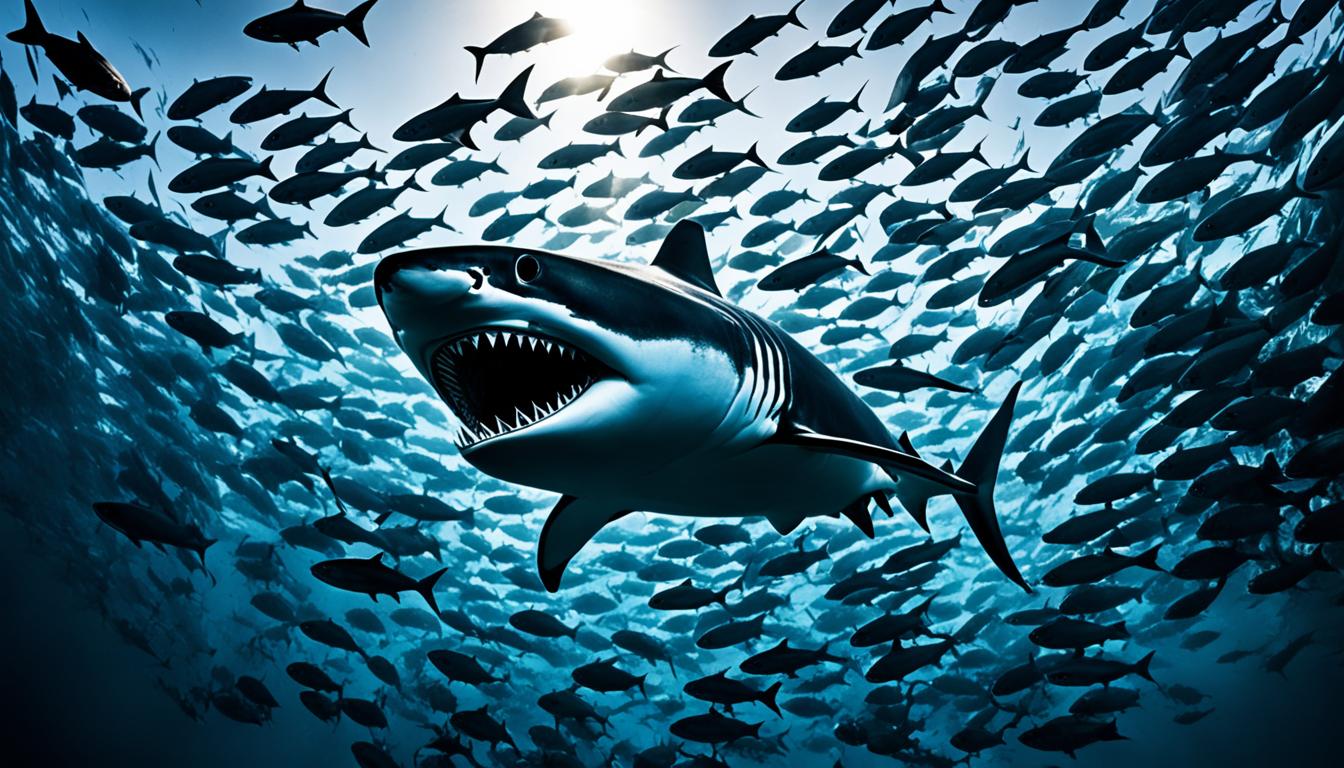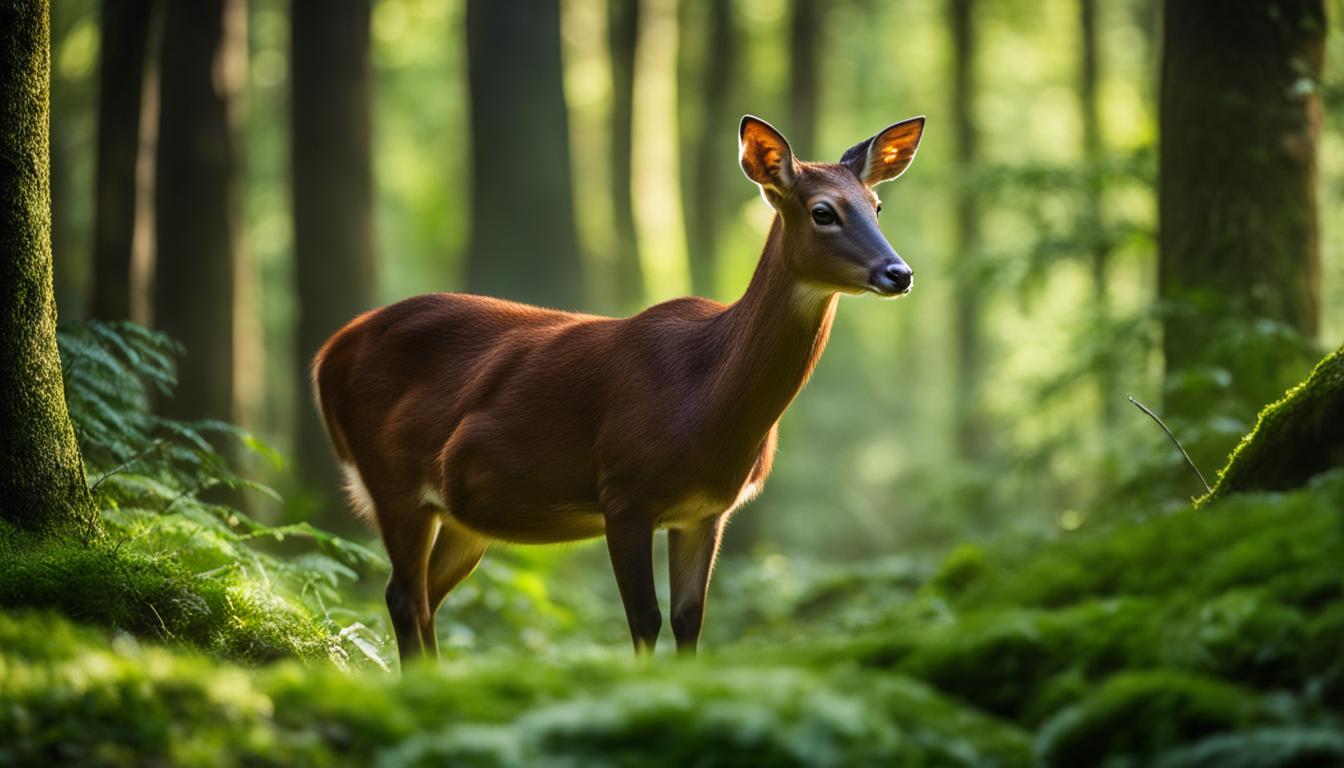Did you know that sharks, the top predators in the ocean, are not indestructible? Despite their dominance in the underwater realm, sharks also face threats from other predators. This article explores the unexpected predators that hunt sharks, revealing the complex relationships within marine ecosystems.
From killer whales to crocodiles, these predators play a crucial role in shaping the balance of life beneath the waves. By understanding the interactions between these apex predators, we gain a deeper appreciation for the delicate ecosystem and the importance of conservation efforts to protect these magnificent creatures.
Key Takeaways:
- Sharks, despite their status as apex predators, are also preyed upon by other animals in the ocean.
- Killer whales, orcas, employ strategic hunting techniques to target and overpower sharks.
- Saltwater crocodiles have been known to hunt and consume smaller shark species that venture into shallow waters.
- Dolphins work together in groups to chase down and kill smaller shark species.
- Octopuses, although uncommon, have been observed to prey on smaller shark species.
The Role of Sharks as Apex Predators
Sharks, such as white sharks, tiger sharks, and bull sharks, are considered apex predators in many ecosystems. As apex predators, they play a crucial role in regulating populations of their prey and influencing the overall health and balance of the food web. Their presence or absence can have cascading effects on the populations of smaller carnivores, known as mesopredators, and other species within the ecosystem.
Apex predators are at the top of the food web and have a significant impact on trophic cascades—a phenomenon where changes in the abundance or behavior of one species affect entire food webs. By preying on and controlling the populations of their prey, sharks help maintain the balance and stability of the ecosystem. They prevent overpopulation of certain species, which in turn prevents overconsumption of other organisms and promotes biodiversity.
Consider an ecosystem without apex predators like sharks. Prey populations would increase exponentially, putting immense pressure on their own food sources and other species within the food web. This imbalance can disrupt the natural dynamics of the ecosystem, leading to species decline or even extinction. Apex predators like sharks act as keystone species, holding the delicate ecosystem together and preserving its intricate interconnections.
Sharks have evolved over millions of years to be efficient and effective hunters. Their physical adaptations, such as sharp teeth, streamlined bodies, and keen senses, enable them to locate, capture, and consume their prey with precision. They have the ability to detect sounds, vibrations, and electromagnetic fields, giving them a distinct advantage when hunting in their aquatic habitats.
Sharks’ role as apex predators extends beyond their direct influence on prey populations. They also shape the behavior and distribution of other organisms, including mesopredators, by influencing where and how they search for food or seek shelter. The absence of sharks can disrupt the delicate balance of the food web, leading to unexpected consequences throughout the ecosystem.
The importance of sharks as apex predators highlights the interconnectedness of marine ecosystems and the intricate web of life. Protecting sharks and their habitats is crucial for maintaining biodiversity, healthy food webs, and the overall balance of our oceans.
Predators Within the Shark Community
While sharks are often seen as apex predators, larger shark species, such as tiger sharks and great white sharks, have been known to exhibit cannibalistic behavior and prey on smaller or younger sharks of the same species. Competition for resources, such as food and territory, can drive this behavior among sharks.
Sharks may turn to intra-species predation, including cannibalism, when faced with limited food sources or when territories overlap. In such cases, larger sharks may take advantage of their size and strength to prey upon smaller individuals of their own species.
This type of cannibalism among sharks is not uncommon and has been observed in various species. For example, tiger sharks, known for their voracious appetites, have been documented feeding on smaller tiger shark pups or juveniles. Similarly, great white sharks, known for their powerful bites, have been observed preying on younger or smaller great white sharks.
Competition for food and territory is one of the main driving factors behind intra-species predation among sharks. Sharks that inhabit the same area and rely on similar food sources may find themselves in direct competition with one another. In such situations, cannibalism becomes a survival strategy, allowing larger sharks to eliminate potential rivals and secure their access to resources.
In addition to competition, territorial disputes can also lead to intra-species predation. Sharks establish territories for various reasons, including mating, feeding, and resting. When one shark encroaches upon another’s territory, aggression and predatory behavior may ensue.
In summary, while sharks are renowned as top predators in the ocean, they are not exempt from cannibalistic behavior and intra-species predation. Competition for food and territory can drive larger shark species to prey upon smaller or younger sharks of the same species. This phenomenon highlights the complex dynamics of marine ecosystems and the fierce competition for survival among these apex predators.
| Intra-species Predation Among Shark Species | Cannibalistic Behavior | Territorial Disputes |
|---|---|---|
| Tiger sharks preying on smaller tiger shark pups or juveniles | Tiger sharks exhibiting cannibalistic behavior | Territorial aggression leading to predation |
| Great white sharks preying on younger or smaller great white sharks | Great white sharks exhibiting cannibalistic behavior | Competition for feeding and resting territories |

Killer Whales: Skilled Shark Hunters
When it comes to hunting sharks, killer whales, or orcas, are highly skilled predators. These magnificent creatures have developed impressive shark-hunting techniques, relying on their intelligence and agility to isolate and incapacitate their prey.
Killer whales exhibit a remarkable strategy when targeting sharks. They work together in coordinated groups, known as pods, to surround their prey and create confusion. By disorienting the shark, they minimize its chances of escape and increase their own chances of a successful hunt.
Once the shark is isolated and weakened, killer whales use their powerful jaws and teeth to deliver fatal blows. Despite the great size and strength of great white sharks, killer whales have been observed to overpower and consume these formidable predators in various parts of the world, showcasing their exceptional hunting skills.
Interactions between killer whales and great white sharks are not uncommon. These encounters often result in killer whales targeting and overpowering the sharks, demonstrating their dominance in the marine food chain.
To better understand the hunting techniques employed by killer whales, let’s take a closer look at some of the key strategies they employ:
- Coordinated Attack: Killer whales work together in groups, often led by a dominant female called the matriarch. By cooperating and communicating effectively, they create a synchronized attack that overwhelms their prey.
- Strategic Hunting: Instead of relying solely on brute force, killer whales use their intelligence to locate and target vulnerable areas of the shark’s body, increasing their chances of incapacitating it quickly.
- Teamwork: Killer whales demonstrate exceptional teamwork during hunts, with some individuals leading the attack while others distract and confuse the shark, minimizing its ability to defend itself.
The complex interaction between killer whales and great white sharks showcases the fascinating dynamics of the ocean’s top predators. By studying these interactions, we can gain valuable insights into the delicate balance of marine ecosystems and the roles played by each species.
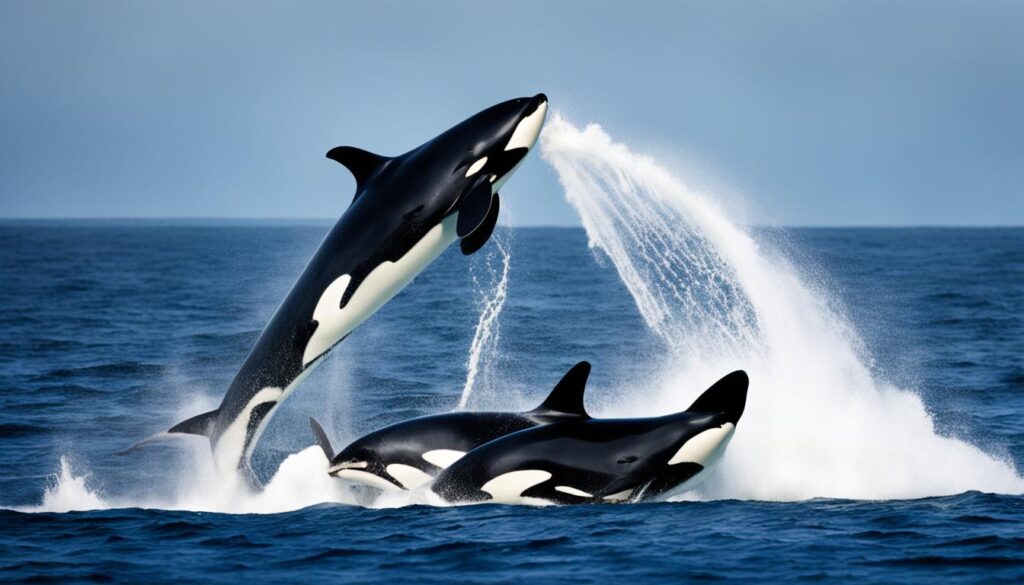
Notable Quote:
“Killer whales are remarkable predators, showcasing their intelligence and agility when hunting sharks.”
Crocodiles: Unlikely Shark Predators
When it comes to shark predation, saltwater crocodiles may not be the first creatures that come to mind. But these formidable reptiles have been known to surprise unsuspecting sharks in shallow waters, demonstrating their ability to overcome and consume smaller shark species.
Equipped with powerful jaws and a stealthy hunting approach, saltwater crocodiles have the advantage in these encounters. Their impressive bite force and ability to camouflage in the water make them formidable predators. Young bull sharks and other smaller shark species seeking refuge in shallows become easy targets for these crocodilians.
“While it may seem unusual for crocodiles to prey on sharks, their opportunistic nature and adaptability enable them to take advantage of available food sources. Shallow water hunting allows crocodiles to ambush sharks, showcasing their remarkable hunting abilities.”
These ambush-style attacks demonstrate crocodiles’ strategic hunting techniques. By lying in wait and springing into action at the right moment, they can overpower and consume unsuspecting sharks. This impressive display highlights the diverse predation strategies employed by different species and the complexity of marine ecosystems.
To further understand the unique dynamics of saltwater crocodile and shark interactions, let’s explore a detailed comparison of their physical characteristics:
| Characteristics | Saltwater Crocodile | Sharks |
|---|---|---|
| Size | Can grow up to 7 meters (23 feet) | Varies based on species; can range from a few feet to over 12 meters (39 feet) |
| Jaw Strength | Impressive bite force; one of the strongest among living creatures | Varies based on species; most sharks possess strong jaws adapted for capturing and tearing prey |
| Habitat | Found in both saltwater and freshwater habitats, including estuaries, rivers, and coastal areas | Found in oceans, seas, and some freshwater systems across the globe |
| Feeding Behavior | Opportunistic predators, feeding on a wide range of prey including fish, reptiles, birds, and mammals | Varies based on species; some feed on small fish while others target larger marine mammals |
As we can see from the table above, saltwater crocodiles and sharks possess unique characteristics that contribute to their respective predatory abilities. While crocodiles are versatile hunters that can adapt to different environments, sharks have evolved various feeding strategies based on their species and habitat.
By exploring the surprising interactions between saltwater crocodiles and sharks, we gain a deeper understanding of the complex dynamics within marine ecosystems. This knowledge is crucial for conservation efforts and ensuring the preservation of these fascinating creatures and their habitats.
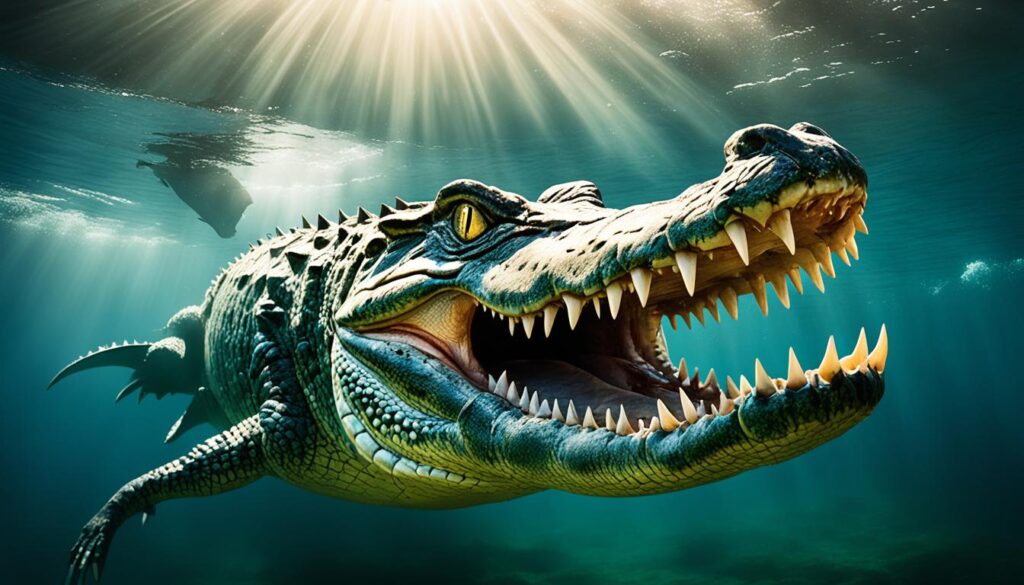
Next Section: Sperm Whales: Deep-diving Predators
Sperm Whales: Deep-diving Predators
Sperm whales are remarkable creatures known for their impressive deep-diving abilities. While their diet mainly consists of squid, they have also been observed engaging in shark predation when squid populations are low or seasonal.
With their powerful jaws and sharp teeth, sperm whales are capable of capturing and consuming various shark species. This behavior highlights the adaptability of these deep-diving predators in the face of changing food availability.
By consuming both squid and sharks, sperm whales play a crucial role in maintaining the delicate balance of the ocean’s food web. As squid are a primary food source for sperm whales, their predation on sharks can help regulate shark populations, ensuring the health and sustainability of the entire ecosystem.
Sperm Whales and Squid Consumption
Sperm whales have a strong affinity for squid, with some individuals consuming hundreds of kilograms of squid each day. Their diet primarily consists of deep-sea squid species, such as the giant squid and the colossal squid.
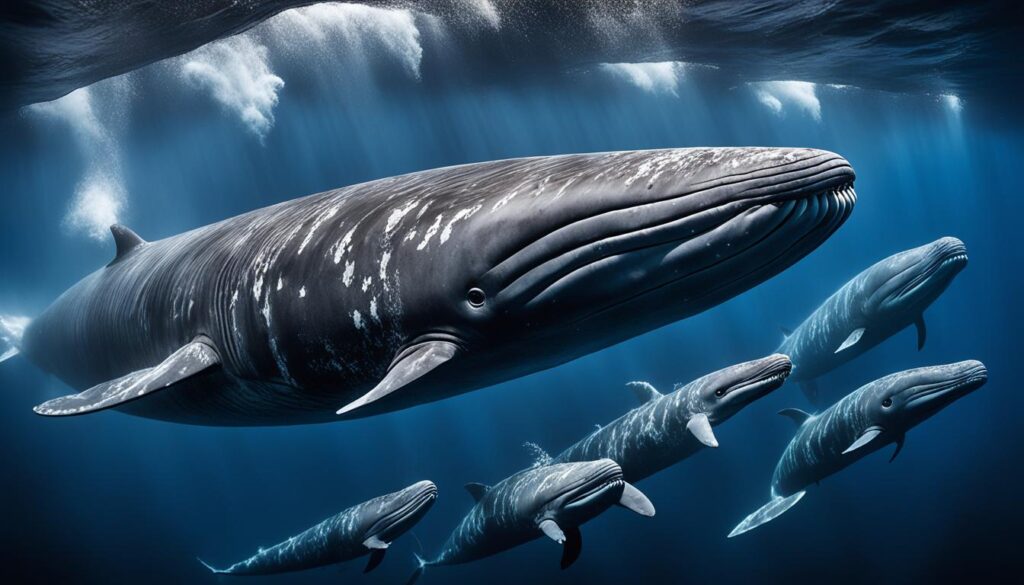
The image above captures the awe-inspiring presence of a sperm whale as it gracefully navigates the depths of the ocean. These magnificent creatures possess the largest brain of any known animal, enabling them to navigate their complex environment and locate their preferred prey.
Through their squid consumption, sperm whales help regulate squid populations, preventing overpopulation and ensuring a stable ecosystem. Without the presence of these deep-diving predators, squid populations could potentially explode, leading to imbalances within the food web.
Sperm Whales and Shark Predation
While squid is the primary component of a sperm whale’s diet, they have also demonstrated the ability to consume sharks. When squid populations are scarce, sperm whales adapt their feeding behavior, targeting sharks as an alternative food source.
“Sperm whales not only exemplify the extraordinary adaptability of nature but also serve as a reminder of the intricate connections within marine ecosystems.”
When sperm whales encounter sharks, they use their impressive size and strength to overpower their prey. Their powerful jaws and sharp teeth allow them to capture and consume sharks with relative ease.
| Sperm Whale Predation on Sharks | Key Points |
|---|---|
| Sperm Whale Diet | Squid, deep-sea species |
| Secondary Diet | Shark species when squid populations are low |
| Predation Technique | Powerful jaws and sharp teeth |
| Ecosystem Impact | Contributes to the balance and sustainability of the food web |
The table above summarizes the crucial aspects of sperm whale predation on sharks. It showcases their dietary flexibility and the significant role they play in maintaining the delicate balance of the ocean’s ecosystem.
The predation of sperm whales on both squid and sharks demonstrates the intricate connections within marine ecosystems. As apex predators, sperm whales contribute to the overall health and sustainability of the ocean, making them a vital part of the complex web of life beneath the waves.
Dolphins: Agile Shark Predators
Dolphins are remarkable creatures known for their intelligence and agility. These cetaceans are not only adept at acrobatic displays and playful behavior but also possess impressive hunting skills. Dolphins have been observed hunting and preying on a diverse range of animals, including sharks.
What sets dolphins apart as formidable predators is their ability to work together in large groups, also known as pods, to accomplish their hunting objectives. Their speed and coordination allow them to chase down and deliver fatal blows to even the most agile shark species.
One technique commonly employed by dolphins when hunting sharks is the mobbing technique. Through this strategy, dolphins isolate and confuse their prey, making it easier to ambush and take down their intended target. By surrounding the shark and swimming in coordinated patterns, dolphins create a disorienting environment for their victim.
“Pods of dolphins are often seen mobbing sharks, using their numbers and synchrony to overpower and prey on these formidable predators. It’s truly fascinating to witness their teamwork and strategic approach.”
This mobbing behavior is not limited to sharks and has also been observed in interactions with other marine animals. Dolphins leverage their social structure and communication skills to execute successful hunts, displaying a level of intellect and adaptability rarely seen in the animal kingdom.
It is important to note that while dolphins are known to prey on sharks, instances of dolphin predation on larger shark species are relatively rare. Dolphins tend to target smaller shark species, taking advantage of their speed and agility to outmaneuver and overpower their prey.

The Role of Dolphins in Marine Ecosystems
Dolphins play a crucial role in maintaining the balance of marine ecosystems. Through their predation of sharks, dolphins contribute to regulating shark populations, preventing potential overpopulation and maintaining ecosystem stability. By targeting smaller shark species, dolphins help maintain a healthy balance within the marine food web.
Beyond their predation behavior, dolphins also serve as indicator species, providing valuable insights into the health of oceans. Their presence or absence in an area can provide important information about the overall well-being of the marine environment.
Octopuses: Uncommon Shark Predators
While not a common predator of sharks, some octopuses have been known to hunt and consume smaller shark species. Octopuses use their tentacles to grab and pull in their prey, but their ability to prey on sharks depends on species differences in size and strength. Larger shark species may even prey on octopuses themselves.
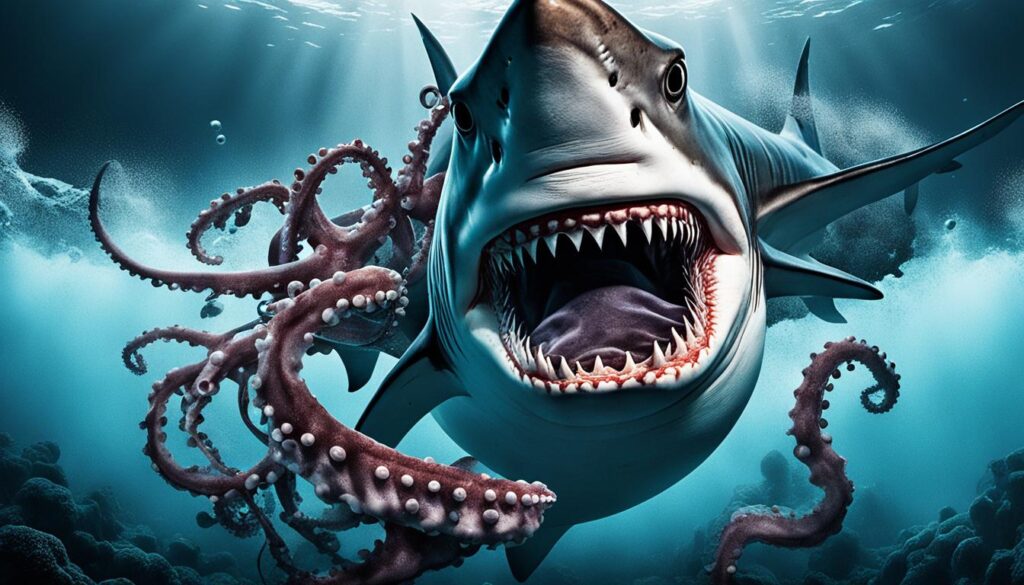
Octopuses are fascinating creatures with remarkable hunting techniques. Their flexible bodies and ability to blend into their surroundings make them stealthy and effective predators. They have been observed using ambush tactics, patiently waiting for an unsuspecting shark to pass by before launching a surprise attack. Once a shark is within reach, the octopus quickly wraps its tentacles around the shark, using its powerful suction cups to maintain a firm grip.
“Octopuses are incredibly intelligent creatures, capable of complex problem-solving and adapting to different hunting situations. Their ability to prey on sharks showcases their versatility as predators in the marine ecosystem.”
Some species of octopuses also employ defensive strategies when hunting sharks. They can release a cloud of ink to disorient the shark, giving the octopus an opportunity to escape or launch a counterattack. This tactic, combined with their mastery of camouflage, makes octopuses formidable opponents for smaller shark species.
Octopuses vs. Larger Sharks
The ability of octopuses to prey on larger shark species is limited due to the significant differences in size and strength. Larger sharks, such as great whites or tiger sharks, possess powerful jaws and are equipped with sharp teeth that can easily injure or kill an octopus. These larger sharks primarily feed on other marine animals, including smaller sharks, fish, and seals.
However, octopuses may still be at risk of predation by larger shark species. Hungry or opportunistic sharks might view an octopus as potential prey, especially if the octopus is smaller or injured. In such cases, the octopus relies on its agility, ability to change color and shape, and release of ink to evade and confuse the shark.
Shark-Octopus Interactions: Nature’s Battleground
The interactions between sharks and octopuses highlight the complex dynamics of predator-prey relationships in the ocean. While some octopuses can prey on smaller sharks, they also face the constant threat of becoming prey themselves when encountering larger shark species. These interactions contribute to the balance and survival of various species in the marine ecosystem.
“The ocean is a battleground for survival, where predators and prey constantly adapt and evolve to outsmart each other. The dynamic between octopuses and sharks is a testament to the intricate web of life beneath the waves.”
Understanding the unique hunting techniques and predator-prey interactions of octopuses and sharks provides valuable insights into the delicate balance of marine ecosystems. Preserving these ecosystems and protecting the diverse range of species within them is crucial for maintaining the health and biodiversity of our oceans.
Parasites, Diseases, and Human Impact on Sharks
Sharks, like any other living organisms, face threats from parasites and diseases. Copepods, tapeworms, and bacterial infections are just a few examples of the many parasites and diseases that can impact shark populations. These organisms can weaken the sharks’ immune systems, affect their reproductive capabilities, and even cause death in extreme cases.
However, the greatest danger to sharks today comes from human activities. Overfishing, driven by the demand for shark fin soup and other shark products, has led to a significant decline in shark populations worldwide. Sharks are often caught unintentionally as bycatch in fishing nets meant for other species, further contributing to their decline.
Habitat destruction is another serious concern. Coastal development, pollution, and destructive fishing practices, such as bottom trawling, destroy vital shark habitats like coral reefs and seagrass beds. With their habitats depleted or destroyed, sharks lose their essential feeding and breeding grounds, impacting their ability to survive and reproduce.
Climate change poses an additional threat to sharks and their ecosystems. Rising sea temperatures and ocean acidification affect the distribution and abundance of important prey species, disrupting the natural balance of marine food webs. These changes can impact the availability of food for sharks, leading to malnutrition and population declines.
“The decline in shark populations due to overfishing and habitat destruction has far-reaching consequences for the health and stability of marine ecosystems.”
It is crucial to recognize the negative impact of these human-driven factors on sharks and take action to protect these incredible creatures. Implementing sustainable fishing practices, establishing marine protected areas, and raising awareness about the importance of sharks in maintaining healthy oceans are critical steps toward safeguarding shark populations and restoring ecosystem balance.
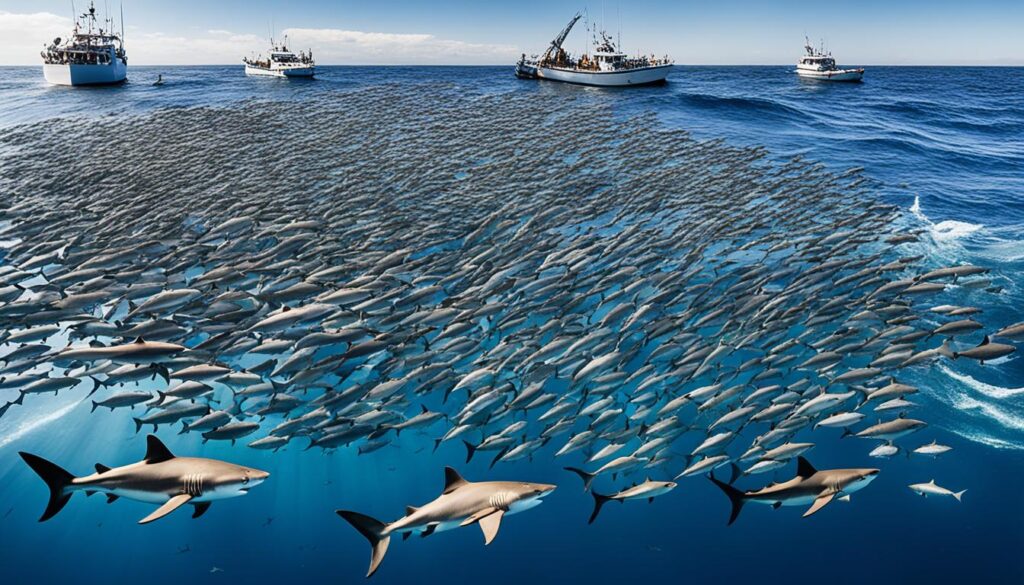
Human Factors Affecting Shark Populations
| Threat | Description |
|---|---|
| Overfishing | Driven by the demand for shark products, leading to population declines |
| Habitat Destruction | Coastal development, pollution, and destructive fishing practices destroy vital shark habitats |
| Climate Change | Rising sea temperatures and ocean acidification disrupt marine food webs and prey availability |
By addressing these human impacts and working towards a more sustainable coexistence with sharks, we can help restore balance to the oceans and ensure the long-term survival of these magnificent creatures.
Conclusion
Sharks, as apex predators in the ocean, hold a crucial position in maintaining the delicate balance of marine ecosystems. Despite their formidable reputation, sharks are not immune to predation themselves. They face a diverse range of natural predators, including killer whales, crocodiles, dolphins, and even octopuses. Understanding the role of these predators is essential for preserving the marine ecosystem’s equilibrium and ensuring the continued survival of sharks.
However, the greatest threat to sharks comes from human actions. Overfishing and habitat destruction have resulted in a significant decline in shark populations worldwide. These activities disrupt the delicate balance of marine ecosystems, jeopardizing not only sharks but numerous other marine species as well. If we do not address the impact of overfishing and habitat destruction, the consequences could be catastrophic for the marine ecosystem’s overall health.
It is imperative that we take immediate and concrete steps to protect shark populations and restore the balance of marine ecosystems. By implementing responsible fishing practices, creating marine protected areas, and raising awareness about the importance of sharks, we can begin to mitigate the damage caused by human activities. Additionally, tackling the broader issues of excessive pollution and climate change is crucial for ensuring the long-term survival and well-being of sharks and the marine ecosystems they call home.
